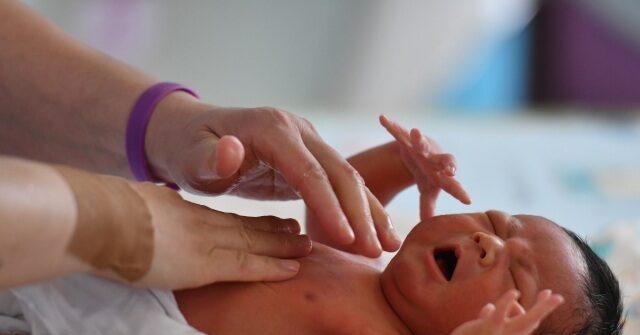
China’s central government issued new “fertility-friendly” guidelines on Tuesday designed to increase the Chinese population, which is currently projected to contract sometime before 2025 following decades of the Chinese Communist Party’s one-child policy, the Global Times reported.
Relaying the edict on August 16, the Chinese state-run newspaper wrote:
A total of 17 Chinese government departments on Tuesday jointly released a guideline on support policies in finance, tax, housing, employment, education and other fields to create a fertility-friendly society and encourage families to have more children, as the country faces growing pressure from falling birth rates.
Tuesday’s guideline was released to implement policies to support each couple to have a third child, push the government, institutions and individuals to fulfill their responsibilities in creating a friendly environment for marriage and fertility, and promote population growth, according to the guideline.
Detailed support policies listed in the guideline included promoting prenatal and postnatal care, further developing nursing systems, improving the mechanism for maternity leave and insurance, offering preferential house-purchase policies to families with more than one child, adding high-quality education resources, creating a fertility-friendly employment environment, and setting up a complete service system on population.
The pro-fertility guidelines released by Beijing on August 16 additionally stipulated a goal of preventing “unwanted pregnancies” and decreasing the number of “non-medical abortions” among Chinese women.
Yang Wenzhuang, the director of population and family affairs at China’s National Health Commission, predicted on July 21 that China’s population will contract by the year 2025. He announced the grim forecast during the 2022 Annual Conference of the China Population Association, according to the Global Times.
“Birth data for 2021 released by 29 provinces and regions in China so far showed that the number of new births in 2021 was the lowest in decades in several provinces,” the newspaper observed on July 24.
China’s government in 2021 recorded the nation’s lowest birth rate in modern history. A “birth rate” is the number of live births per 1,000 people in a population, as defined by the World Bank.
“Subtracting the crude death rate from the crude birth rate provides the rate of natural increase, which is equal to the rate of population change in the absence of migration,” the global lender explains on its website.
China’s birth rate last year was 7.52 births per 1,000 people, or the lowest birth rate Beijing has documented since China’s National Statistics Bureau started collecting relevant data in 1949.
“The natural growth rate of China’s population, which excludes migration, was only 0.034% for 2021, the lowest since 1960,” Reuters reported on January 17 citing Chinese government statistics.
The Chinese Communist Party enforced an infamous one-child policy from about 1980 to 2016 that the Party still boasts to this day “prevented” 400 million people from being born. The scheme, which encouraged abortions, was originally designed to contain China’s booming population growth at the end of the 1970s. The decades-long one-child policy had unforeseen negative repercussions on the health of China’s population, however, resulting in warped demographics and a low fertility rate. Beijing loosened the birth cap allowance to two children in 2016 and further increased this limit to three children by May 2021.
“According to the latest figures from China’s National Bureau of Statistics, China’s population grew from 1.41212 billion to just 1.41260 billion in 2021 – a record low increase of just 480,000, a mere fraction of the annual growth of eight million or so common a decade ago,” the BBC observed on June 5.
China’s population may have already experienced a decrease in its growth rate sometime before November 2021, according to the opinion of an independent demographer named He Yafu.
“There will be between 9.5 million to 10.5 million newborn babies this year,” He wrote in a social media post, as quoted by Bloomberg on November 10, 2021.
“If the number of newborns is near the lower limit of the prediction, that means the population will register negative growth as there’s been an average of about 10 million deaths a year recently,” he wrote.

